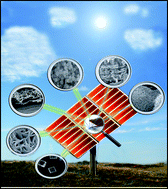A review on counter electrode materials in dye-sensitized solar cells
Abstract
Dye-sensitized solar cells (DSCs) present promising low-cost alternatives to the conventional silicon (Si)-based solar cells. A DSC consists of several components, the most prominent being a titanium dioxide/metal oxide-based photoanode, a dye, an electrolyte and a counter electrode. The photoexcited electrons from the dye diffuse through the TiO2 network in the photoanode and go to the counter electrode which generally consists of platinum (Pt) sputtered onto a fluorine-doped tin oxide (FTO) plate. The Pt in the counter electrode helps in the regeneration of dyes by catalysing the I− regeneration from the I3− species in the redox couple. The morphology of Pt, its surface roughness, nature of the exposed facet, etc. play a crucial role in determining the overall efficiency of a DSC device. With Pt being a costly noble metal, reasonable efforts have been made to find cheaper alternatives. The review presented below gives a succinct summary of the materials in use as counter electrodes in DSCs, with a conclusion and future prospects section.

- This article is part of the themed collection: JMC A Top Picks collection: Harnessing the power of the sun

 Please wait while we load your content...
Please wait while we load your content...